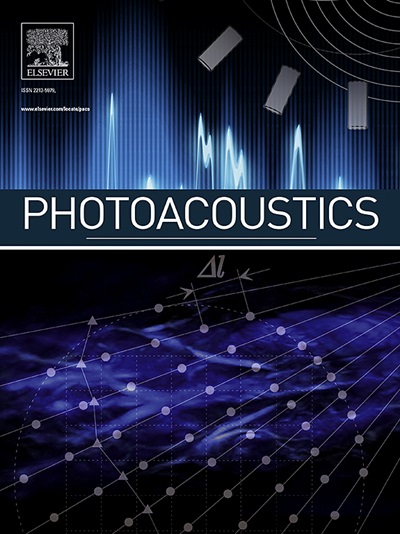Temperature dependence of femtosecond photoacoustic process in high-precision characterization for metal nanofilms
IF 7.1
1区 医学
Q1 ENGINEERING, BIOMEDICAL
引用次数: 0
Abstract
Femtosecond photoacoustic detection is a powerful all-optical technique for characterizing metal nanofilms. However, the lack of accurate descriptions of the temperature-dependent optical properties of metal nanofilms during ultrafast thermal processes hinders the deep understanding of this dynamic behavior, leading to compromised measurement accuracy. To address this, we developed Critical Point Models (CPMs) for copper and AlCu nanofilms to describe their dynamic optical properties during photoacoustic testing. By integrating dynamic behavior into ultrafast laser-matter interaction and acousto-optic processes, we explored the temperature effects throughout testing. Numerical simulations were performed to analyze the temperature, stress, and surface reflectivity distributions of the nanofilms. Compared to experimental results, our dynamic models significantly improved prediction accuracy for both copper and AlCu nanofilms. This highlights the importance of temperature dependence in femtosecond photoacoustic testing and validates our model's capability to capture the behavior of metal nanofilms under ultrafast laser irradiation.
飞秒光声过程在金属纳米膜高精度表征中的温度依赖性。
飞秒光声探测是表征金属纳米膜的一种强大的全光技术。然而,在超快热过程中,缺乏对金属纳米膜的温度依赖光学特性的准确描述,阻碍了对这种动态行为的深入理解,导致测量精度受损。为了解决这个问题,我们开发了铜和AlCu纳米膜的临界点模型(cpm)来描述它们在光声测试中的动态光学特性。通过将动态行为整合到超快激光-物质相互作用和声光过程中,我们在整个测试中探索了温度效应。通过数值模拟分析了纳米膜的温度、应力和表面反射率分布。与实验结果相比,我们的动态模型显著提高了铜和AlCu纳米膜的预测精度。这突出了飞秒光声测试中温度依赖性的重要性,并验证了我们的模型在超快激光照射下捕获金属纳米膜行为的能力。
本文章由计算机程序翻译,如有差异,请以英文原文为准。
求助全文
约1分钟内获得全文
求助全文
来源期刊

Photoacoustics
Physics and Astronomy-Atomic and Molecular Physics, and Optics
CiteScore
11.40
自引率
16.50%
发文量
96
审稿时长
53 days
期刊介绍:
The open access Photoacoustics journal (PACS) aims to publish original research and review contributions in the field of photoacoustics-optoacoustics-thermoacoustics. This field utilizes acoustical and ultrasonic phenomena excited by electromagnetic radiation for the detection, visualization, and characterization of various materials and biological tissues, including living organisms.
Recent advancements in laser technologies, ultrasound detection approaches, inverse theory, and fast reconstruction algorithms have greatly supported the rapid progress in this field. The unique contrast provided by molecular absorption in photoacoustic-optoacoustic-thermoacoustic methods has allowed for addressing unmet biological and medical needs such as pre-clinical research, clinical imaging of vasculature, tissue and disease physiology, drug efficacy, surgery guidance, and therapy monitoring.
Applications of this field encompass a wide range of medical imaging and sensing applications, including cancer, vascular diseases, brain neurophysiology, ophthalmology, and diabetes. Moreover, photoacoustics-optoacoustics-thermoacoustics is a multidisciplinary field, with contributions from chemistry and nanotechnology, where novel materials such as biodegradable nanoparticles, organic dyes, targeted agents, theranostic probes, and genetically expressed markers are being actively developed.
These advanced materials have significantly improved the signal-to-noise ratio and tissue contrast in photoacoustic methods.
 求助内容:
求助内容: 应助结果提醒方式:
应助结果提醒方式:


